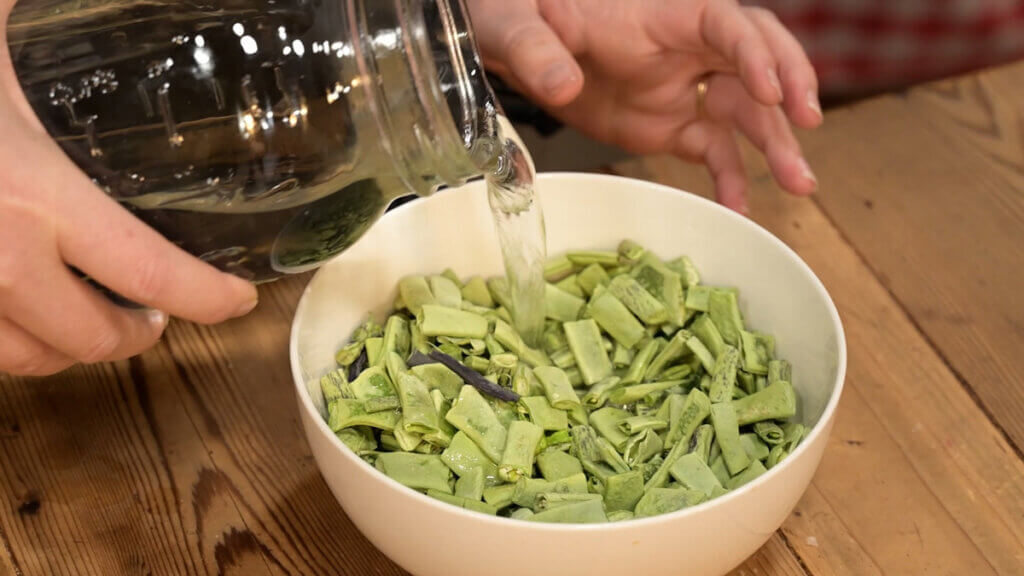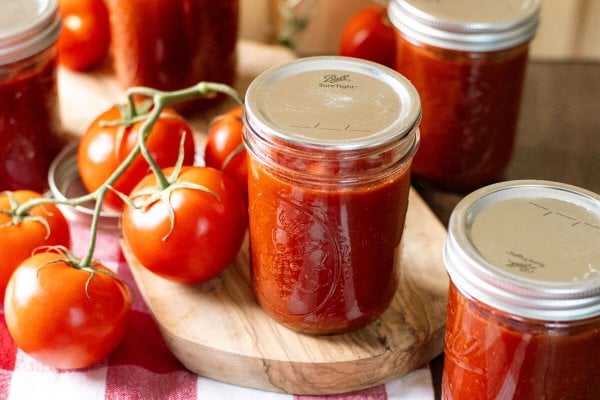Whether you’re a homesteader building up your long-term food storage, an avid outdoor enthusiast, or a prepper, proper food storage is essential when it comes to maintaining the quality, taste, and nutritional value of your freeze dried food.

By following this guide, you’ll be able to optimize the shelf life of your freeze dried items and have peace of mind knowing that your food is well-preserved, even in emergency situations.
Table of Contents
ToggleWhy I Love Freeze Dried Food
The availability of home freeze dryers has revolutionized the way I preserve my food at home. There are some foods that you should not freeze dry, and I’m grateful that I have other food preservation methods such as home canning, dehydrating, or fermenting. Yet, time and time again, I find myself gravitating towards my freeze dryer any chance that I get.
I can now say there are many reasons we love freeze drying, and it’s at the top of my list for preservation methods.
Freeze drying provides a shelf-stable preservation option that retains up to 97% of nutrients, creates security in emergency preparedness, and even offers great versatility in home cooking. You can incorporate it into various recipes to create complete and nutritious meals.
Whether you’re camping, traveling, or simply looking for a convenient way to accomplish from-scratch meals with healthy ingredients, freeze dried food can be a reliable choice. Freeze drying baby food means I can pack up his food and have it ready in minutes when we’re on the road.
While following freeze dried tutorials and stocking your pantry is important, it’s equally as important to know how to store freeze dried food safely and properly to preserve the hard work you put into your preserved foods.

Why Doesn’t Freeze Dried Food Go Bad?
In truth, freeze dried food can go bad, but when it comes to food preservation, freeze dried food stands out for its remarkable shelf life. So, have you ever wondered why freeze dried food doesn’t go bad like raw or natural foods?
Freeze drying is a unique method of food preservation that involves removing moisture from the food while it’s frozen. This process maintains the nutritional value, flavor, and texture of the food, ensuring that it can be stored for an extended period without spoiling.
Unlike dehydrated foods, which retain some moisture, freeze dried food is completely dry, eliminating the conditions necessary for bacterial growth.
The freeze drying process begins by freezing the fresh food. It is then placed in a vacuum chamber where the pressure is reduced, causing the water in the food to transform from a solid (ice) to a gas (vapor) without passing through a liquid state.
This process, known as sublimation, effectively removes the water content while preserving the food’s structure and integrity.
By removing moisture, freeze drying prevents the growth of spoilage-causing microorganisms and the enzymatic reactions that can cause food to go bad. The resulting freeze dried food retains its original taste, color, and nutrients, making it an excellent choice for long-term storage and emergency preparedness.

How to Store Freeze Dried Food
It is important to remember that freeze drying prevents the growth of microorganisms but does not make spoilage impossible. This is why it is so important to understand how to store your freeze dried food properly.
What Affects the Shelf Life of Freeze Dried Food
Four key components will affect the shelf life of your freeze dried food.
- Oxygen – One of the critical factors in preserving the freshness of freeze dried food is minimizing its exposure to oxygen. When oxygen is introduced, freeze dried food begins to reabsorb it, allowing the food to begin losing its nutrients, vitamins, flavor, and color.
- Moisture – Moisture is the enemy of freeze dried food. It is essential to store your food in a dry environment to prevent moisture absorption and potential spoilage. Avoid areas with high humidity levels, such as basements or poorly ventilated spaces.
- Light – It is important to keep your freeze dried food away from sunlight or any exposure to light. Light can cause oxidation and degrade the quality of the food over time.
- Heat – Temperature control is crucial for maintaining the quality of freeze dried food. It is recommended to store your supplies in a cool environment, away from heat sources that could accelerate the degradation process. Aim for a consistent temperature between 50-70°F (10-21°C).

Best Packaging for Freeze Dried Food
When it comes to storing freeze dried food, choosing the right containers is crucial for maintaining its quality and extending its shelf life. These are some of our favorite freeze drying supplies.
- Mylar Bags With Oxygen Absorbers – These strong and durable bags provide an airtight and moisture-resistant barrier, further protecting your food from spoilage. To maximize the effectiveness of Mylar bags, it’s essential to store your freeze dried food with oxygen absorbers. The combination of oxygen absorbers and Mylar bags creates an optimal storage environment, ensuring the longevity of your freeze dried supplies. This is also the best option if you plan on taking your food backpacking.
- Mason Jars – I like using Mason jars for storing freeze dried food because they are reusable, but using them for extended storage of freeze dried food comes with some considerations.
- Mason jars are not completely airtight, and they allow some oxygen to penetrate over time. Our goal is to grow and preserve a year’s worth of food, so this does not pose a problem for us. We use a jar sealer to initially remove the oxygen and then use it again after each time the jar has been opened.
- Mason jars do not provide the same level of protection against light exposure as Mylar bags do. Light can degrade the nutritional content and flavor of the food, leading to a deterioration in quality. This obstacle can easily be handled by storing freeze dried food in a dark space away from light.
- Vacuum Seal Bags – Vacuum seal bags create an airtight environment that helps protect your freeze dried food from exposure to air and moisture. By removing the air from the bag, you can significantly save space and slow down the oxidation process, preserving the quality and flavor of your food for a longer time. While vacuum seal bags can be an excellent choice for storing freeze dried food, there are a few considerations to keep in mind.
- The first is ensuring that the bags are properly sealed. Any unsealed areas can compromise the airtight environment, reducing the effectiveness of the bags in preserving the food’s freshness. Be sure to follow the manufacturer’s instructions on sealing the bags correctly.
- Secondly, it’s essential to use bags that are specifically designed for vacuum-sealing food. Regular zip-top bags don’t have the necessary barriers to protect against oxygen and moisture, potentially leading to spoilage. Investing in high-quality vacuum seal bags designed for food storage is crucial to maintaining the integrity of your freeze dried food.
- Lastly, it’s worth mentioning that vacuum seal bags are not suitable for long-term storage of freeze dried food. While they can help extend the shelf life, for prolonged storage, it’s still advisable to use more durable containers such as Mylar bags or Mason jars.
| Storage Conditions | Recommended | Avoid |
| Light | Dark storage area | Direct sunlight |
| Temperature | 50-70°F (10-21°C) | Heat sources |
| Moisture | Dry environment | High humidity |

Steps to Take BEFORE You Store Your Freeze Dried Food
Before packaging your freeze dried food for long-term storage, follow these guidelines to ensure success.
- Make Sure Your Food Is Completely Dry – Freeze dried food will feel dry and crispy when finished. When possible, try to freeze dry portions that are uniform in size. If the freeze drying cycle is complete and your food still feels moist, spongy, soft or cool to the touch, place the food back in the freeze dryer for more time.
- Select Air Tight Containers – One of the key factors in preserving the freshness of freeze dried food is minimizing its exposure to oxygen. Mason jars and Mylar bags are my containers of choice.
- Only Use Clean, Dry Containers – We love Mason jars because they are reusable, but always make sure the container you choose has been thoroughly cleaned and dried before packaging your freeze dried food.
- Keep Away from Strong Odors – Odors can easily infiltrate and affect the taste and quality of freeze dried food. Make sure to store your freeze dried meals away from strong-smelling substances such as cleaning products, chemicals, and even certain spices. This will help maintain the integrity of your food and prevent any unwanted flavors or odors.
- Use Oxygen Absorbers – These small packets contain iron powder that reacts with oxygen, effectively removing it from the sealed container. By eliminating oxygen, you prevent oxidation and the growth of bacteria, mold, and other microorganisms that can spoil your food.

How to Store Freeze Dried Food
As mentioned, there are multiple ways to store your freeze dried food. Achieving a proper vacuum seal on the food is where the safety and longevity of the food is key. There are a few ways to vacuum seal your freeze dried food for long-term storage. For these examples, I’ll be demonstrating with Mason jars.
- Vacuum Chamber – The best way to vacuum seal food is with a vacuum chamber, but most freeze drying enthusiasts don’t have one of those lying around.
- Food Saver – If you have a food saver, this vacuum jar sealer attachment can be used to seal your jars. However, it can be a bit cumbersome to get out of the pantry when I just want to vacuum seal one jar.
- Electric Vacuum Sealer – There are electric rechargeable vacuum jar sealers that I absolutely love. This is probably the one I reach for most often to simply reseal a jar of freeze dried food after I’ve dipped into it.
- Hand Pump Vacuum Sealer – Because I always want to be prepared in case of a short or long-term power outage, I love having backup solutions to my everyday conveniences. This hand-pump vacuum sealer from ForJars fits the bill.

Using a Food Saver
- Prepare your freeze dried food and place it into a Mason jar along with an oxygen absorber.
- Center the flat portion of a two-piece Mason jar lid onto the jar.
- Using the vacuum sealer lid attachment (and hose), carefully place the vacuum sealer lid onto the jar, pressing down firmly until you’re sure it’s in place.
- On the food saver machine, choose the accessory mode and just let it do its thing.
- Once the machine turns off, you can remove the adapter and check the seal of the lid.

Using an Electric Food Saver
- Prepare your freeze dried food and place it into a Mason jar along with an oxygen absorber.
- Center the flat portion of a two-piece Mason jar lid onto the jar.
- Carefully place the electric vacuum sealer onto the jar, pressing down firmly until you’re sure it’s in place.
- Press the power button and let the vacuum sealer run for about 15-20 seconds (depending on the size of the jar) or until the machine stops automatically (depending on the brand you are using).
- Carefully remove the vacuum sealer and check the seal of the lid.

Using a Hand Pump Vacuum Sealer
- Prepare your freeze dried food and place it into a Mason jar along with an oxygen absorber.
- Center the flat portion of a two-piece Mason jar lid onto the jar.
- Using the vacuum sealer lid attachment, place the hand pump into the hose valve and manually pump the air out of the jar.
- You’ll notice the pump starts having some resistance once the air is removed.
- Carefully remove the vacuum sealer attachment and check the seal of the lid.

How to Tell if Freeze Dried Food Has Gone Bad
While freeze dried food has an incredibly long shelf life, it’s important to be vigilant and aware of potential spoilage risks. The most important test is to feel the food to be sure it’s still crispy/crunchy. If it has gone spongy at all, it has absorbed moisture and should be discarded.
One such risk is the growth of botulism, a potentially life-threatening illness caused by the ingestion of toxin-producing bacteria called Clostridium botulinum. While the risk of botulism in freeze dried food is extremely low, it’s important to remain cautious and vigilant.
Here are some key points to understand about botulism and freeze dried food:
- Botulism bacteria require certain conditions to grow, including low oxygen, moist environments, and a pH level above 4.6.
- The freeze drying process removes moisture from the food, creating an inhospitable environment for bacterial growth, including Clostridium botulinum.
- Properly processed and stored freeze dried food is generally safe from botulism contamination.
- If you have any concerns about the safety of your freeze dried food, it’s best to err on the side of caution and avoid consuming it.

When it comes to freeze dried food, assessing its quality and freshness is key to enjoying a delicious and nutritious meal. Here are some practical tips to help you check for signs of spoilage or loss of quality:
- Visual Inspection – Start by visually examining the freeze dried food. Look for any discoloration, mold growth, or unusual textures. If you notice any of these signs, it may indicate that the food has gone bad.
- Aroma Test – Give the freeze dried food a sniff. If it has an off-putting or rancid smell, it’s best to avoid consuming it.
- Touch/Feel – The next thing I do is to give the freeze dried food a feel. Does it still crumble between your fingers. Is it still crispy/crunchy? If it is spongy at all, it should be discarded.
- Rehydration Test – Rehydrate a small portion of the freeze dried food according to the instructions. Check if it rehydrates fully and retains its original texture. If it remains tough or exhibits mushy consistency, it may have lost its quality.
- Taste Test – While freeze dried food generally retains its original flavor, it’s essential to do a taste test before consuming it. If the taste is unpleasant or different from what you expect, it might be an indication of spoilage.
- Expiration Date – When purchasing freeze dried foods, always check the expiration date on the packaging. Consuming the food beyond its expiration date may result in diminished quality and taste. Homesteading Hack: Implementing a first-in, first-out (FIFO) system can help you manage your inventory effectively and avoid any waste. By consuming and replacing older items, you ensure that you always have fresh and nutritious options available.

Becoming a Freeze Drying Master
Did you know that when it comes to freeze drying, every food is unique and can have minor differences that either make or break your success?
In my book Freeze Drying the Harvest: Preserving Food the Modern Way
I’ve included specific, detailed guidance on how to freeze dry all your foods properly.
I’ve covered all the things I wish I knew when I first started freeze drying, like…
- Why you should be freeze drying
- How to choose the right freeze dryer
- How to set up your freeze dryer
- How much it actually costs to run a freeze dryer
- How to maintain your freeze dryer
- What other equipment you really need (or don’t)
- Which foods you can freeze dry
- Which foods you cannot freeze dry
- Food safety with freeze drying
- How to rehydrate your freeze dried foods
Is learning easier when you have video visuals to guide you through the process step-by-step? Then, my Freeze Drying Masterclass has you covered!
These resources can be purchased separately or as companions, so whether you choose the book or the masterclass, you will receive all the information I wished I had when I first began my freeze drying journey.

Other Articles You May Enjoy
- Honest Review of the Harvest Right Freeze Dryer
- Freeze Dried vs. Dehydrated Foods – What’s the Difference?
- What Foods Cannot Be Freeze Dried
- Harvest Right Freeze Dryer FAQs
- How to Use Oxygen Absorbers
- Rehydrating Freeze Dried Foods
- Freeze Dried Water (Can It Be Done?)
- How to Freeze Dry Candy: Easy Step-by-Step Guide


















